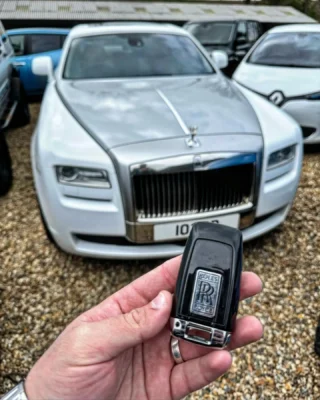
28
junioThe Smart Key Repair Mistake That Every Beginning Smart Key Repair User Makes

Smart Key Repair: Understanding the Technology and Solutions
In today's hectic digital world, smart keys have actually become a necessary function in the majority of modern-day cars. Unlike standard keys, smart keys offer drivers with improved security and benefit, permitting keyless entry and beginning of the vehicle. However, like any technological advancement, smart keys are not unsusceptible to problems. Understanding how smart keys work, common issues that emerge, and options readily available for repair can empower vehicle owners to make educated choices regarding their smart key systems.
What is a Smart Key?
Smart keys, likewise called key fobs or distance keys, are electronic gadgets that enable the user to unlock and begin their vehicle without physically placing a key into the lock or ignition. Instead, the vehicle detects the proximity of the key and performs the required functions immediately.
Key Components of a Smart Key:
- Transmitter: Sends radio signals to the vehicle.
- Receiver: Located within the vehicle; identifies the signal from the transmitter.
- Battery: Powers the smart key and its functions.
- Microchip: Encodes the frequency and other data needed for performance.
Advantages of Smart Keys:
- Convenience: Unlocks doors, starts the ignition, and can even stop the engine without key insertion.
- Security: Incorporates innovative encryption technology to avoid unauthorized access.
- Customizable Functions: Many smart keys permit users to customize settings for various motorists.
Typical Problems with Smart Keys
While smart keys boost security and user experience, they can also encounter issues that necessitate repair. Here are a few of the most typical problems related to smart keys:
| Problem | Description |
|---|---|
| Dead Battery | The most typical concern; a dead battery renders the key unusable. |
| Signal Interference | Interference from other electronic gadgets can interrupt the signal. |
| Physical Damage | Dropping or exposure to water can damage key parts. |
| Programming Errors | Misconfiguration can cause the key to become unresponsive. |
| Used Contacts | Internal components can wear out with heavy use. |
Dead Battery: Signs and Solutions
Among these issues, a dead battery is the most convenient to fix. Indications that the battery may be dead consist of:
- Difficulty opening doors remotely.
- Failure to begin the vehicle.
- Sluggish action time from the key fob.
How to Replace the Battery of a Smart Key:
- Identify Battery Type: Look for the battery enter the owner's manual or on the battery itself.
- Open the Key Fob: Use a small screwdriver to separate the two halves of the fob thoroughly.
- Replace the Battery: Remove the old battery and replace it with a new one, making sure correct polarity.
- Reassemble the Key: Snap the two halves back together.
Signal Interference: Identifying the Cause
Signal disturbance can be a significant problem, especially in city environments where many electronic gadgets exist. To identify if your smart key is impacted:
- Move far from prospective sources of interference (e.g., radio towers, electronic stores).
- Check the type in an open space.
If the problem persists, think about speaking with a professional.
Physical Damage: Prevention Tips
Preventing physical damage to your smart key is essential. Here are some ideas to preserve your key's integrity:
- Use a Keychain: Attach the smart key to a keychain to prevent dropping.
- Prevent Water: Keep your type in a dry location and prevent exposure to rain or liquid.
- Store Safely: Use a protective case when not in usage.
Programming Errors: Fixing the Issue
In many cases, the key might need to be reprogrammed. This can happen after replacing the battery or if the vehicle's system has been reset. To reprogram a smart key:
- Refer to the Manual: Locate programming guidelines specific to your vehicle design.
- Utilize the Ignition: Usually, the vehicle must be on; follow the series detailed in the handbook.
- All at once press buttons: You may require to push particular buttons on the key.
If the problem persists, getting in touch with a professional locksmith or the dealer is recommended.
Fixing vs. Replacing a Smart Key
When confronted with a malfunctioning smart key, vehicle owners often come to grips with the decision to repair or change. Here's a breakdown:
When to Repair:
- Battery Replacement: If the problem is simply a dead battery.
- Minor Physical Damage: If the key can be quickly repaired or straightened.
- Reprogramming: If errors can be dealt with by following the user handbook.
When to Replace:
- Severe Damage: If the fob is broken beyond easy repair.
- Cost-efficient: Sometimes, a new key might cost less than substantial repairs, specifically if more than one part is damaged.
- Outdated Technology: If the vehicle is very old and the key technology is outdated, changing it may use much better functionality.
Regularly Asked Questions (FAQs)
1. How long does a smart key battery last?
The battery normally lasts between 1 to 3 years, depending upon use and environmental elements.
2. Can I configure my smart key myself?
In many cases, you can program your smart key by following the owner's manual guidelines. Nevertheless, advanced models might need professional assistance.
3. What should I do if my smart key is lost?
If your smart key is lost, instantly notify your car dealership or locksmith. They can help you with a replacement or reprogramming services.
4. Are smart keys universal?
No, smart keys are generally set particularly for specific vehicle models and producers, which suggests a key Stuck in ignition from one brand typically will not deal with another.
5. How can I avoid my smart key from malfunctioning?
To prevent malfunction, prevent exposing the key to extreme temperatures, wetness, and physical damage, and replace the battery routinely.
Smart key systems streamline vehicle gain access to and improve security but featured their own set of obstacles. Comprehending typical issues and repair alternatives can assist vehicle owners preserve functionality and extend the life of their smart keys. With suitable care, users can delight in the full advantages of this innovative innovation for several years to come.


Reseñas